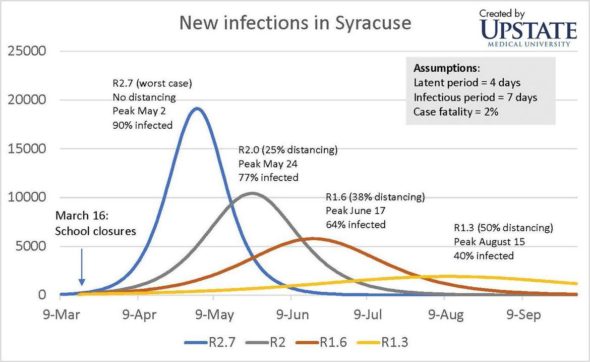Epidemiology is the study of the distribution and determinants of health-related states or events (including disease), and the application of this study to the control of diseases and other health problems.
World Health Organization
They should know better.

Since the early part of the week, my answer has been the same: “They are far smarter than me. I don’t understand how they’ve come to get their curve to look like that, but it doesn’t make sense to me. I’ll try to figure it out later.”
Later is today and today I’m pissed.
I would expect better from a high school senior. Seriously. It is that bad. It draws ridiculously unreasonable conclusions that are implausible and defy direct observation. It is meaningless drivel. This isn’t even science; it is bullshit.
If this is what passes for epidemiology – and I know better than to think that it does – then we’re fucked and science is dead. The creators of this “model” should be ashamed of themselves. This is a 11th grade math project, not science.
Ultimately, epidemiology is very much a science that measures human behavior and tries to determine the impact that said behaviors have on the health of a given population. For the authors of this model to take some very select cell phone data and extrapolate these outcomes from it in vaccum is ridiculous. That isn’t epidemiology, it’s basic proportions. All they did was take the Imperial Model’s worst case scenario and applied it to CNY (which probably only took a representative population-proportion of the USA predictions), then looked at a website that showed cell phones traveling out of the home 50% less than they did pre-Covid, and just reduced the R(0) by 50%.
That isn’t science; there is no evidence that would indicate that such an assumption could even possibly be true. Such a model doesn’t take into account behavior change. Sure, my phone might be with me in the grocery store only 50% less than it would have in January, but that doesn’t necessarily mean that my risk of contracting COVID-19 is reduced by only 50%. This model takes an “all-things-being-equal”-approach while simultaneously flat-out-knowing with certainty that nothing is actually equal.
Before I enter the grocery store, I check my temperature twice daily. I have spent a larger portion of my day away from people. I don’t visit my family. I avoid someone who is coughing. I minimize the number of surfaces that I touch. I wash my hands more often. I don’t touch my hands to my face.
At the grocery store, I walk in with clean hands. I wash the cart before using it. Presumably the store is disinfecting nightly. I keep my distance from others when inside. They are keeping their distance from me. I am wearing a mask, most other people are now too. I check-out my own groceries, so no one else is touching them.
When I return home, I wash all the items before shelving them.
These behaviors matter. They matter a lot. These behaviors are possibly more impactful than immediate distancing itself (not staying home, but instead maintaining a 6-foot distance when in the community). These behaviors #flattenthecurve, and almost everyone is integrating them into their lives (admittedly to varying degrees).
For the epidemiologists at Upstate to blindly release this model for public consumption without any such considerations is disappointing at best, abhorrent at worst. It is shoddy and dishonest science and our community deserves better.